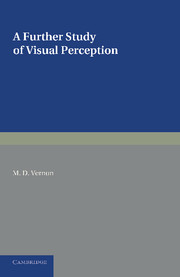Book contents
- Frontmatter
- Contents
- List of Illustrations
- Acknowledgements
- Chapter I INTRODUCTION
- Chapter II THE NATURE OF PERCEPTION
- Chapter III THE PERCEPTUAL PROCESS
- Chapter IV THE DETERMINATION OF FORM
- Chapter V SPATIAL PERCEPTION
- Chapter VI THE CONSTANCIES
- Chapter VII THE FUNCTIONS OF THE FRAMEWORK IN PSYCHO-PHYSICAL EXPERIMENTS
- Chapter VIII THE PERCEPTION OF MOVEMENT
- Chapter IX MICHOTTE'S STUDIES OF SOME INTRINSIC PHENOMENA OF EXPERIENCE
- Chapter X THE INFLUENCE OF INTERNAL AND INDIVIDUAL FACTORS UPON PERCEPTION
- Chapter XI CONCLUSION
- Appendix A
- Appendix B
- References
- Index of Authors
- Index of Subjects
Chapter VII - THE FUNCTIONS OF THE FRAMEWORK IN PSYCHO-PHYSICAL EXPERIMENTS
Published online by Cambridge University Press: 05 June 2016
- Frontmatter
- Contents
- List of Illustrations
- Acknowledgements
- Chapter I INTRODUCTION
- Chapter II THE NATURE OF PERCEPTION
- Chapter III THE PERCEPTUAL PROCESS
- Chapter IV THE DETERMINATION OF FORM
- Chapter V SPATIAL PERCEPTION
- Chapter VI THE CONSTANCIES
- Chapter VII THE FUNCTIONS OF THE FRAMEWORK IN PSYCHO-PHYSICAL EXPERIMENTS
- Chapter VIII THE PERCEPTION OF MOVEMENT
- Chapter IX MICHOTTE'S STUDIES OF SOME INTRINSIC PHENOMENA OF EXPERIENCE
- Chapter X THE INFLUENCE OF INTERNAL AND INDIVIDUAL FACTORS UPON PERCEPTION
- Chapter XI CONCLUSION
- Appendix A
- Appendix B
- References
- Index of Authors
- Index of Subjects
Summary
THE INDIFFERENCE POINT AND THE CENTRAL TENDENCY OF JUDGEMENT
We must now devote some attention to considering a mass of data relating to the type of ‘constant’ errors that occur in psycho-physical experiments. By ‘constant’ errors we mean those which constantly occur in the same way, and are not mere chance variations. At first sight this problem may appear highly esoteric and remote from everyday life. But further examination seems to show that in fact it constitutes one more example of the attempt to cope with an unfamiliar situation involving a particularly difficult type of judgement by employing all previous relevant experience as a framework to which the present perception may be anchored, and by means of which it may be stabilized.
In the last chapter we mentioned the ‘central tendency of judgement’ Shown particularly by children in making size judgements— that is, the tendency to equate the median of a series of variables with the standard, no matter what the actual range of variables presented. This central tendency resembles that which has long been known to exist in psycho-physical measurement—the tendency of constant errors in judgement to distribute themselves about some central point usually called the ‘indifference point’. Thus Warren and Shaw (1895) showed that in estimating the size of squares, one at the upper end of the series of magnitudes presented was under-estimated, and one at the lower end was over-estimated. That is to say, the indifference point, where there was no constant error in either direction, tended to fall somewhere towards the middle of the series. A great deal of evidence has also been obtained using non-visual material. We shall include some of this, since the problem is similar for all classes of stimuli. Thus Hollingworth (1909) showed the existence of the indifference point for hand-and-arm movements of different lengths. He used three different series of lengths, and in each case the indifference point was situated approximately at the centre of the range of that particular series. Yet cases do seem to occur when, if the effect of a particular range of stimuli is eliminated, an absolute indifference point may appear.
- Type
- Chapter
- Information
- A Further Study of Visual Perception , pp. 149 - 161Publisher: Cambridge University PressPrint publication year: 2013



